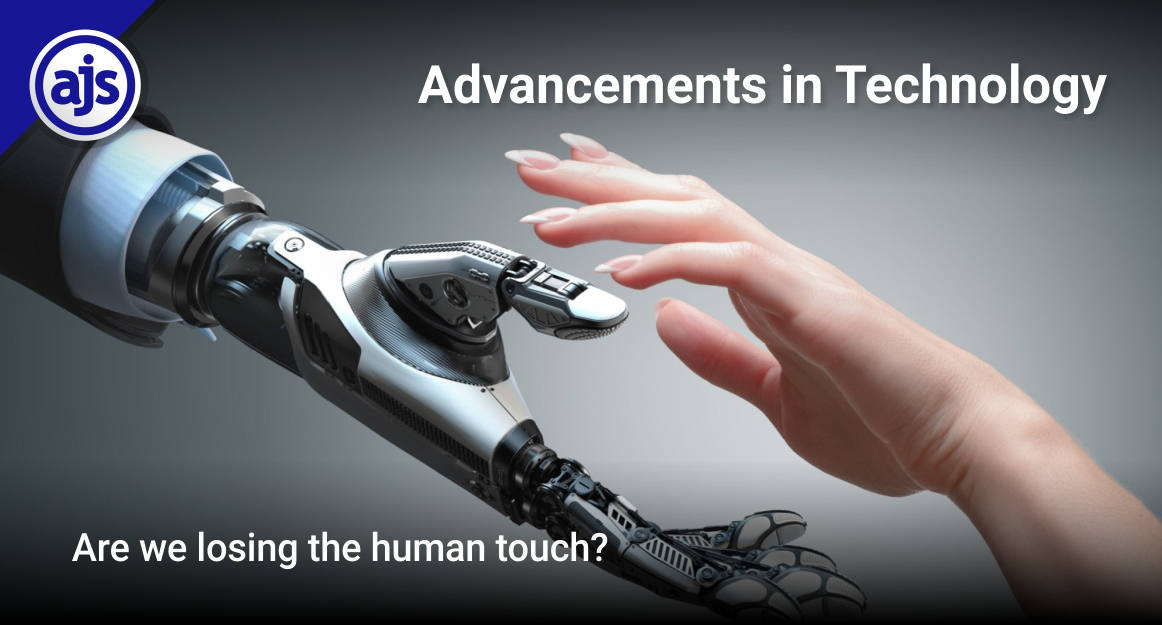
Advancements in Technology
Are we losing the human touch?
Touch.
It’s a cognitive, physical, thing. Something we feel. Something intentional. Something palpable.
And it’s important.
In fact, Psychology Today believes that “the need for human touch is one of our most basic, primal needs”. But in today’s age there is seemingly less touch. Less human interaction. Less humanity in our day-to-days.
Think of our Teams or Zoom calls – we are all in different spaces, all talking to each other through a microphone. And half the time the camera is off. Is that the “human interaction” we’re looking for?
Online shopping? The online bit says it all. We choose items we want, put them into a virtual basket and checkout using online payment apps or credit cards. Interacting with the delivery person is also now restricted what with packages soon-to-be delivered by drone deliveries.
Tech and AI dominate the modern world.
“From the proliferation of AI and machine learning to the ubiquity of cloud computing, businesses today have a plethora of tools at their disposal” (The Imperative of Technology with a Human Touch in the Modern Business Landscape).
Everything nowadays is built to promote efficiency – being able to get more done, in less time, with less wastage of human involvement. Boosting productivity is top on the list of our goals. Our world is seemingly inclined to be faster, better, smarter which is all very well, as it allows for improved customer satisfaction and bang for the buck.
But one has to ask – where is the human touch in all of this?
Is human touch still important?
There’s no denying that technology has enabled humans to improve on their output, enabling everyday tasks to become easy as pie whilst also encouraging staff to employ their skills elsewhere thus promoting the need to upskill and think more creatively, often across teams.
But it’s Forbes that sets the scene for us –
“Technology isn’t going anywhere, and as it continues down the unending path of innovation, it’s only going to become a bigger part of our daily lives.
Chief among the many benefits of technology is the ability to save precious time on repetitive tasks, boost productivity, track employee performance, and allow for swifter and easier communication. The downsides have also been well-documented, particularly the risk of making us feel more isolated, putting cybersecurity and privacy at greater risk and throwing the work-life balance slightly off-kilter.
Technology has eliminated much of the need for face-to-face human interaction, both between employees as well as between businesses and customers. In some ways, this has made things more efficient, but it’s also left many of us feeling lonely.
Never has the human touch been so important.
Implementing technology with a human touch is vital for your internal staff. When employees (and clients for that matter) engage with your company (leadership, co-workers, etc.) they want the respect and empathy they can only get from another human being. They want employers who can respond to their concerns in real time and demonstrate emotional intelligence. They see a human voice as more trustworthy, which could lead to an overall more positive experience. This shows that your company sees employees as individuals”.
And that’s not all, in the article Technology With a Human Touch: The Workforce of the Future Is Wired Differently –
Technology is only as powerful as the people who build, use, and improve it. “In our fascination with technology, sometimes we neglect to recognise that the true potential of technology isn’t realised unless you have the human touch. Machines take on routine operations, but we have to infuse human creativity, ethics, and strategic judgment,” says Ashley Grice, CEO of global creative consultancy.
BCG BrightHouse
Sure, if we think about it, tech and AI can only do so much before the input of an actual human is necessary.
So, what do we do about it?
A change of mindset
It’s about challenging the assumptions of how humans and tech interact.
As set out by Bloomberg –
“Artificial intelligence and other technologies can provide the tools necessary to empower each person in your company to innovate like a rockstar CTO.
But is that enough?
Reimagining how AI and other technologies can unleash human ingenuity and creativity requires a complete change of mindset and culture.
To be successful, you must encourage and embrace edgy ideas, and, most importantly, have the grit to adapt and change quickly.”
It’s about bringing back the human touch to tech, in a way that enables both humans and technology to work optimally.
In the LinkedIn article The Imperative of Technology with a Human Touch in the Modern Business Landscape the author sets out as follows –
“On one hand, technology offers the promise of streamlined operations, reduced overheads, and enhanced customer experiences. On the other, an over-reliance on technology can lead to impersonal interactions, creating a chasm between businesses and their customers.
The key to navigating this conundrum lies in striking a balance. Technology should be viewed as an enabler – a tool that augments human capabilities rather than replacing them.
As we look ahead, the future of business lies in the seamless integration of technology and human touch. Companies that recognise this will not only stay relevant but will also set themselves apart in an increasingly competitive market.
Technology can provide data, insights, and solutions, but it’s up to humans to interpret, understand, and act upon them with empathy. Empathy builds trust, fosters loyalty, and creates lasting customer relationships”.
And we couldn’t agree more.
The importance of the human touch is highlighted by Wired in the article Balancing act: Why Tech Will Always Need the Human Touch –
“We can’t have it both ways. The reality is human intervention, understanding and judgement are responsible for both the successes and apparent failings of technology. The key to unlocking the full potential of technology is striking the right balance.
If we design, develop, and deploy technology without the right combination of human perspectives and understanding woven in, we risk building something with poor user experience and inappropriate functionality – as well as potentially jeopardising cyber security and resilience. And when we place too much blind faith in technology, we abdicate responsibility and risk leaving our skills and judgement to atrophy and ethical issues to arise.”
And what do all the above resources have in common? The undeniable conclusion that the human touch is needed to ensure that technology is implemented in the manner it was meant to be – by enhancing the user experience and allowing for a boost in productivity. Not for the replacing of humans in their roles. Rather a deployment of human staff into different roles that require empathy, reasoning, creativity, and ability to change and adapt as the environment changes.
How do we go about merging the human touch and tech?
It’s plain as day that humans are still very much needed, no matter how fast technology may be advancing. So, how do we go about fusing the two – at almost opposite ends of the spectrum?
- It starts with understanding that technology is a tool that humans use to improve their workspace. And it needs to be used as such – as a tool, as an enabler, as an enhancement. Not a replacement of. And the human touch is needed to plug in the points where tech falls short. A symbiotic relationship where both parts use the other to promote an improved outcome.
- Promotion of education – online learning platforms and e-learning courses have made professional development a cinch. Instead of looking to replace employees with tech, encourage the embracing of tech as a tool to learn and as a tool to grow in a role (Medium).
- Reskill employees – in conjunction with education and upskilling, companies can reskill their employees by teaching them new methods and ways of working. By doing this, many workers can fill digital roles (Bloomberg)
- Exercising compassion – with employees often working remotely, feelings of isolation and loneliness are bound to increase. It’s therefore critical for businesses to promote employee wellbeing. Use tech to offer wellness programs, mental health resources, and online communities where employees can share their experiences and seek support (Medium).
- Communication is key – gone are the days of working in silos. Today’s world demands that teams work in collaboration with one another. Being able to communicate across different platforms and across teams becomes crucial. Use tech to adopt a platform-style model that encourages communication and collaboration among teams across departments and jurisdictions. At the same time, when a clear mission is combined with a shared way of working, it creates a platform that supports everything from customer-facing processes to operations (Medium).
- Having purpose – “having a shared purpose is the cohesive force needed to keep teams united, motivated, and focused, even when they’re working great distances apart. Real conversations among thinkers, candid debates about ethical guardrails, and groundbreaking ideas forged from creative energy can only come to life when purpose binds an organization together. So, purpose and strategy must be well defined, communicated, and woven into the fabric of an organization to reap all of the benefits of humans and technology working together” (Bloomberg).
It would seem that without the human touch, tech is not entirely used to its best potential. Just like how the absence of human touch can result in loneliness and depression, the absence of “human touch” when applying it to tech can have the same adverse reaction – the dismal performance of tech and investment of money in tech that just doesn’t work optimally.
At AJS we don’t replace humans. Instead, we take on more work and continually improve on our service using tech. We encourage our clients to do the same.
(Sources used and to whom we give thanks: Psychology Today; Insider Intelligence; Forbes; Bloomberg; Medium; Wired and LinkedIn).
To find out how to incorporate a new tool into your existing accounting and practice management suite, feel free to get in touch with AJS – we have the right combination of systems, resources and business partnerships to assist you with incorporating supportive legal technology into your practice. Effortlessly.
AJS is always here to help you, wherever and whenever possible!
– Written by Alicia Koch on behalf of AJS





Leave a Reply